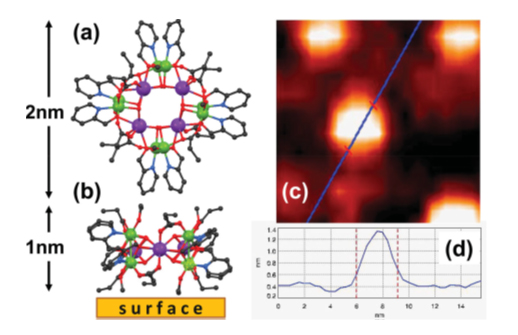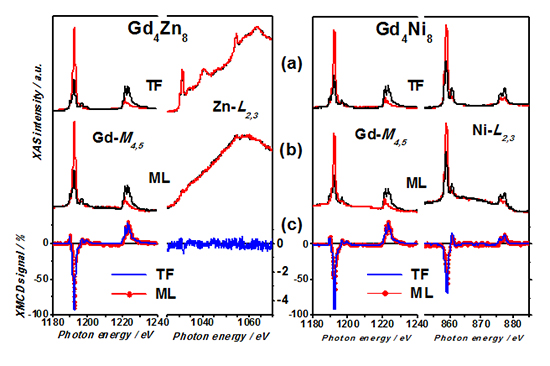An Italian-British team has come to SOLEIL to use the DEIMOS beamline to investigate single molecule coolers deposited on a gold surface. They observed that the deposition process did not alter the electronic, magnetic and thermodynamic properties of the molecules, opening the way for exploitable cooling processes at molecular level.

Figure 1. a,b) Molecular structure, dimensions and orientation of the Gd4M8 cluster with
respect to the surface. Colour scheme: Gd, large purple circles; M(= Zn, Ni), green; O, red; N,
blue; C, black.
As materials are getting smaller and smaller, we now see potentials for using single molecules as electronic devices. One of the remaining questions is: will functionalities be preserved at the molecular scale? In the last decades, nanomagnets and in particular molecular magnets have been developed as an alternative route for refrigeration at cryogenic temperatures. Among these molecules, some rely on the so called “Magnetocaloric effect” (MCE), i.e. change of thermal properties when applying a magnetic field. In other words, using a magnetic field it is possible to initiate a cooling process at a molecular level!
However, until now, none of them have been studied when isolated on a surface; would high (MCE) be preserved or not? The challenge was double: finding a suitable molecule that can be safely dispersed as individual objects in a matrix or on a surface while preserving its MCE. And finding suitable experimental tools to probe the magnetic properties at the single molecular level.
Two teams from the University of Modena (Italy)and the University of Edinburgh have focused their joint efforts on a series of Gd-based molecular clusters, Gd4M8 (where M stands for zinc or nickel); a family of compounds recently synthesized and showing large (MCE). The molecules were deposited on Au(111) and HOPG surfaces, and their integrity was tested by several surface characterization techniques (Atomic Force Microscopy, Scanning Tunneling Microscopy, and X-ray Photoelectron Spectrometry, see figure 1). When satisfying coverage was achieved, the researchers came to SOLEIL to use the DEIMOS beamline, the soft x-ray beamline at SOLEIL dedicated to the study of magnetic materials and highly optimized for low dimensionality measurements (molecular and atomic monolayer or sub-monolayer). Scientists were very careful not to damage the molecules by optimizing the incident photon flux. Thus they were able, using soft X-rays absorption (XAS) and X-rays magnetic circular dichroism (XMCD) spectroscopies to verify that the electronic and the magnetic properties of the isolated molecules were preserved upon deposition (see figure 2 for comparison of XAS and XMCD spectra recorder for thin films (TF) and monolayer –ML) of Gd4M8 on Au(111)). Eventually the researchers were able to demonstrate that MCE could be observed in isolated molecules on surface.

Figure 2: Gd-M4,5 and Zn-L2,3 (left panel), and Ni-L2,3 (right panel) absorption edges spectra taken using both photon helicities with the related dichroic signal (c) measured at 3K and 6T for the ML of Gd4Zn8 (Gd4Ni8) on Au(111) (b) and the corresponding TFs (a). The Zn XMCD for the ML (not shown) is zero within an error-bar for the noise of ±5%.
